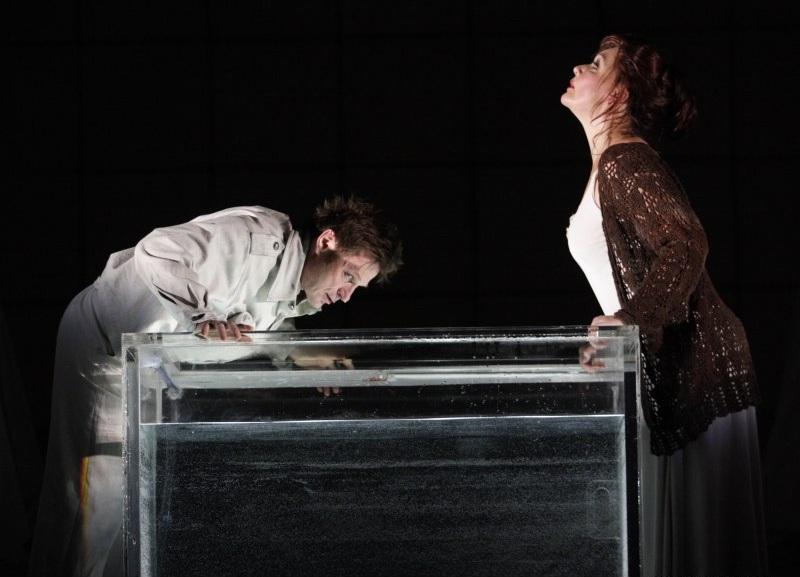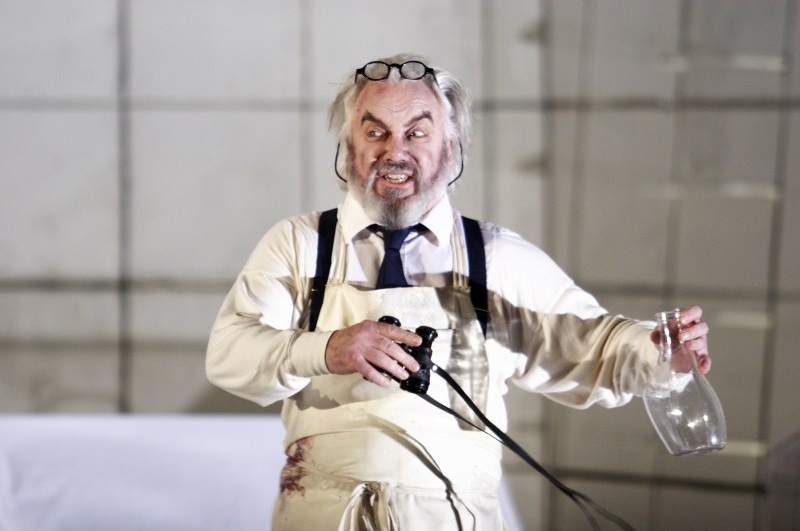Wozzeck, Royal Opera | reviews, news & interviews
Wozzeck, Royal Opera
Wozzeck, Royal Opera
A superb cast and orchestral perfection bring the best out of a rather overbearing production

You could hardly ask for a better cast than the one assembled for this short run of Wozzeck at the Royal Opera House: Simon Keenlyside in the title role, Karita Mattila, John Tomlinson, Mark Elder in the pit. And at a top price of £65, with many tickets going for much less, this is quite the bargain – not least because the marquee names absolutely nail the performance.
Keenlyside jitters and stiffens as Wozzeck gets progressively consumed by imagined and real-life torments, while harnessing the strange lyricism of his vocal lines. Mattila, her voice full and perfectly controlled, brings a poignancy to the adulterous but long-suffering Marie. Meanwhile, Tomlinson uses his magnetic stage presence and flawless delivery to disturbing effect as the unscrupulous Doctor (pictured below). The supporting roles are also well handled by Gerhard Siegel (Captain), Endrik Wottrich (Drum Major), John Easterlin (Andres), Allison Cook (Margret) and the rest of the cast.
Wozzeck is a work still staggeringly modern and vital 91 years down the line
The orchestra plus on- and off-stage bands complete the picture – it really is an as-near-as-damn-it ideal account of Berg's first opera, a work still staggeringly modern and vital 91 years down the line. Strange then that it should be the staging that feels like it hasn’t aged well since its first outing a mere 10 years ago. Director Keith Warner and set designer Stefanos Lazaridis, the latter sadly no longer with us, were the dream team behind Covent Garden’s much admired Ring, yet the approach here tends occasionally to undermine the drama.
 The main set is a strange lab-like space with mildew blooming in the corners, a white tiled box with a raked floor, its seams drawing the eye into a trick of perspective. It's dominated by four large glass boxes, initially covered in white sheets but gradually revealed to show one containing giant mushrooms, one specimen jars, one a model of house in the mountains, and one just water.
The main set is a strange lab-like space with mildew blooming in the corners, a white tiled box with a raked floor, its seams drawing the eye into a trick of perspective. It's dominated by four large glass boxes, initially covered in white sheets but gradually revealed to show one containing giant mushrooms, one specimen jars, one a model of house in the mountains, and one just water.
Twice, an upside-down black triangle as wide as the stage is lowered down to reveal a window cut into it, then a few minutes later flown back out again. It all feels somehow significant but that’s really the problem – should one be puzzling over what the staging might mean when there’s a human tragedy unfolding?
Not that it is short of memorable and affecting touches: thanks to the illusionist’s trick of a large angled mirror, Marie first appears pinned to the back wall like a butterfly; in a grizzly coup de theatre, Wozzeck’s death ends with him suspended in a bloody aquarium like a specimen. But there is very little of the mundane, impoverished normality which might allow us to see Wozzeck as a broken human being, rather than just a symbol amid a sea of symbols.
rating
Explore topics
Share this article
The future of Arts Journalism
You can stop theartsdesk.com closing!
We urgently need financing to survive. Our fundraising drive has thus far raised £49,000 but we need to reach £100,000 or we will be forced to close. Please contribute here: https://gofund.me/c3f6033d
And if you can forward this information to anyone who might assist, we’d be grateful.

Subscribe to theartsdesk.com
Thank you for continuing to read our work on theartsdesk.com. For unlimited access to every article in its entirety, including our archive of more than 15,000 pieces, we're asking for £5 per month or £40 per year. We feel it's a very good deal, and hope you do too.
To take a subscription now simply click here.
And if you're looking for that extra gift for a friend or family member, why not treat them to a theartsdesk.com gift subscription?
more Opera
 Madama Butterfly, Irish National Opera review - visual and vocal wings, earthbound soul
Celine Byrne sings gorgeously but doesn’t round out a great operatic character study
Madama Butterfly, Irish National Opera review - visual and vocal wings, earthbound soul
Celine Byrne sings gorgeously but doesn’t round out a great operatic character study
 theartsdesk at Wexford Festival Opera 2025 - two strong productions, mostly fine casting, and a star is born
Four operas and an outstanding lunchtime recital in two days
theartsdesk at Wexford Festival Opera 2025 - two strong productions, mostly fine casting, and a star is born
Four operas and an outstanding lunchtime recital in two days
 The Railway Children, Glyndebourne review - right train, wrong station
Talent-loaded Mark-Anthony Turnage opera excursion heads down a mistaken track
The Railway Children, Glyndebourne review - right train, wrong station
Talent-loaded Mark-Anthony Turnage opera excursion heads down a mistaken track
 La bohème, Opera North review - still young at 32
Love and separation, ecstasy and heartbreak, in masterfully updated Puccini
La bohème, Opera North review - still young at 32
Love and separation, ecstasy and heartbreak, in masterfully updated Puccini
 Albert Herring, English National Opera review - a great comedy with depths fully realised
Britten’s delight was never made for the Coliseum, but it works on its first outing there
Albert Herring, English National Opera review - a great comedy with depths fully realised
Britten’s delight was never made for the Coliseum, but it works on its first outing there
 Carmen, English National Opera review - not quite dangerous
Hopes for Niamh O’Sullivan only partly fulfilled, though much good singing throughout
Carmen, English National Opera review - not quite dangerous
Hopes for Niamh O’Sullivan only partly fulfilled, though much good singing throughout
 Giustino, Linbury Theatre review - a stylish account of a slight opera
Gods, mortals and monsters do battle in Handel's charming drama
Giustino, Linbury Theatre review - a stylish account of a slight opera
Gods, mortals and monsters do battle in Handel's charming drama
 Susanna, Opera North review - hybrid staging of a Handel oratorio
Dance and signing complement outstanding singing in a story of virtue rewarded
Susanna, Opera North review - hybrid staging of a Handel oratorio
Dance and signing complement outstanding singing in a story of virtue rewarded
 Ariodante, Opéra Garnier, Paris review - a blast of Baroque beauty
A near-perfect night at the opera
Ariodante, Opéra Garnier, Paris review - a blast of Baroque beauty
A near-perfect night at the opera
 Cinderella/La Cenerentola, English National Opera review - the truth behind the tinsel
Appealing performances cut through hyperactive stagecraft
Cinderella/La Cenerentola, English National Opera review - the truth behind the tinsel
Appealing performances cut through hyperactive stagecraft
 Tosca, Royal Opera review - Ailyn Pérez steps in as the most vivid of divas
Jakub Hrůša’s multicoloured Puccini last night found a soprano to match
Tosca, Royal Opera review - Ailyn Pérez steps in as the most vivid of divas
Jakub Hrůša’s multicoloured Puccini last night found a soprano to match
 Tosca, Welsh National Opera review - a great company reduced to brilliance
The old warhorse made special by the basics
Tosca, Welsh National Opera review - a great company reduced to brilliance
The old warhorse made special by the basics

Add comment